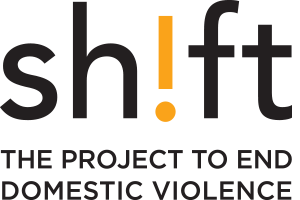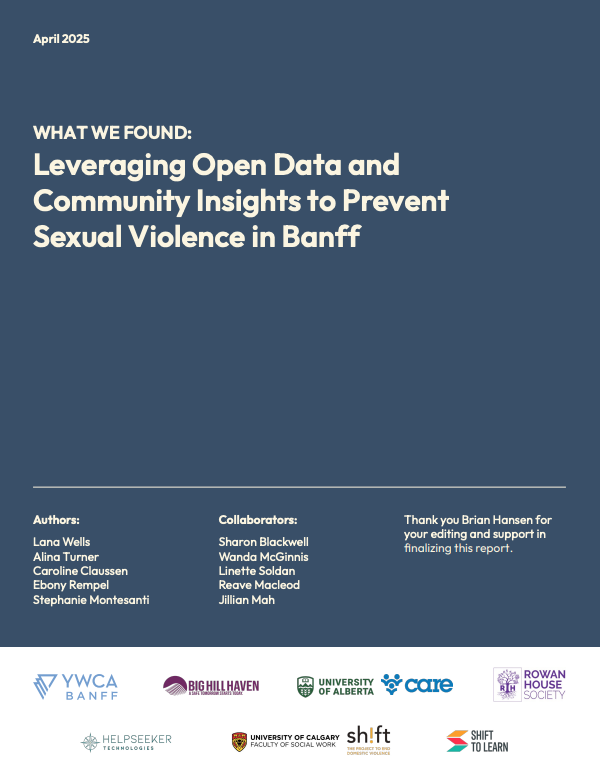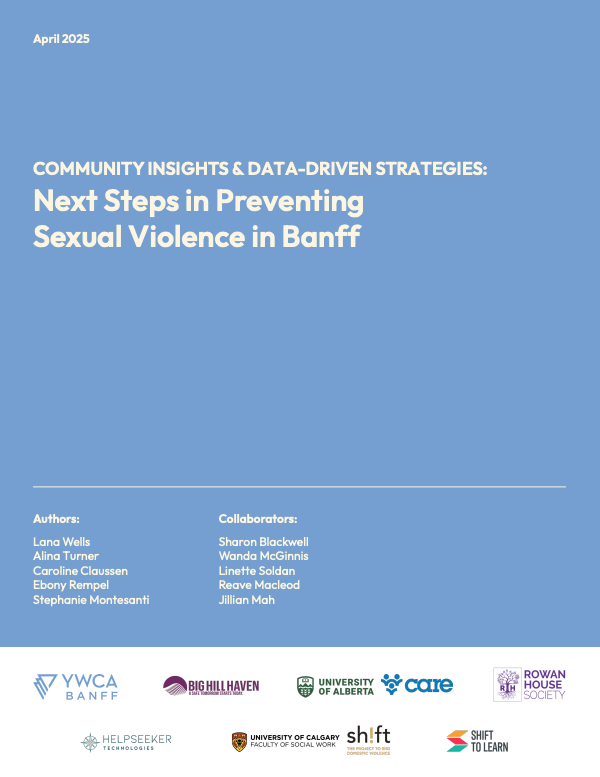‘Made in Alberta’ Rural Collaborative to Stop the Perpetration of Violence

Gender-based violence is pervasive across Alberta — but for those living in rural and remote communities, the risks are higher, and the challenges more complex.
That’s where the Made in Alberta Rural Primary Prevention Collaborative comes in.
To respond to the disproportionate rates of gender-based violence in rural Alberta, Shift has partnered with three women’s shelters — YWCA Banff, Big Hill Haven in Cochrane, and Rowan House Society in High River — to launch the Made in Alberta Rural Primary Prevention Collaborative.
Together with local leaders, we’re examining the root causes of violence, identifying risk factors for male perpetration, and co-creating community-driven solutions to stop harm before it starts.
This is prevention done the Alberta way: community-led, research-backed, and grounded in the realities of rural life.
Applying Primary Prevention in Rural and Small-Town Alberta
 Gender-based violence isn’t just the result of individual choices — it’s also influenced by how our community’s function, what society accepts, and who holds power.
Gender-based violence isn’t just the result of individual choices — it’s also influenced by how our community’s function, what society accepts, and who holds power.
Primary prevention is about stopping violence before it starts. It focuses on shifting the community conditions that increase the risk of someone choosing to use violence. That means promoting gender equality, fostering healthy relationships, and supporting social norms that reject violence — so people are less likely to cause harm in the first place.
In rural and small-town communities, primary prevention requires proactive, community-led strategies shaped by the people who live there. These approaches build on each community’s strengths and are tailored to local social and economic realities.
Why This Project Matters
Why focus on preventing male perpetration of violence?
In Canada, men perpetrate most of the violence experienced by all genders. Men:
- Commit 99% of sexual assaults against women 1
- Commit 93% of sexual assaults against men 1
- Commit 83% of all violence against women 2
- Are 3X more likely to offend criminally, including violent crime 3
The evidence is clear: we need to stop placing the burden of safety on survivors.
Real change means shifting some of our focus — and our resources — toward changing the people, norms and systems that enable harm in the first place.
If we’re serious about ending gender-based violence, we must meet men where they are — in the spaces they naturally gather — and engage them as allies in prevention. Real change starts by supporting men to be part of the solution and helping stop violence before it starts.
Why focus on community-level change in small towns and rural communities?
In rural Alberta, the risks of experiencing and perpetrating violence are higher — and so is our resolve.
Nearly 1 in 5 Albertans live in rural communities, where the risk of domestic and sexual violence and homicide is higher. To prevent gender-based violence, we must understand and address the unique social, economic and geographic factors that contribute to perpetration of violence. In many rural areas, there are specific risk factors.
At the individual level, this can include a history of experiencing or witnessing violence substance use, adherence to rigid gender norms and beliefs in male dominance, mental health challenges, unresolved trauma, low educational attainment, and lack of employment.
At the community level, risk factors can include community tolerance for violence and harmful gender norms, lack of awareness, weak sanctions against perpetrators, geographical distance, lack of anonymity, and lack of housing, childcare, or employment supports for families.
In addition, many small towns and rural communities often lack the resources, programs, and trained professionals needed to intervene early and support people — especially men — before harm occurs. Preventing perpetration in rural Alberta means investing in local, trauma-informed, and community-led solutions that address the root causes of violence.
Ending gender-based violence in Alberta starts at the community level. That’s why we’re investing in local, rural-led solutions — working with industry and community leaders in Banff, Cochrane, and High River to build capacity and drive proactive, community-powered prevention.
Our Approach

To end gender-based violence in small towns and rural communities, we need to start with the insights of local leaders who are already working to end gender-based violence.
Our 8-phase approach moves from insight to action to drive real change by:
- Building leadership capacity to champion and implement primary prevention approaches.
- Leveraging local and open-source data to uncover patterns of violence perpetration.
- Gathering community insights to understand what drives and disrupts violence locally.
- Identifying practical, real-world solutions with diverse communities and sectors.
- Co-creating tailored, actionable strategies with local leaders and everyday Albertans.
- Supporting implementation of primary prevention strategies across the community.
- Measuring impact to strengthen accountability and ensure long-term change.
- Assessing feasibility and adapting strategies for use in other communities.
Local roots, local change: we’re turning community findings into real prevention in Banff, High River, and Cochrane.
The Communities

To begin our work, the Made-in-Alberta Rural Collaborative collected open-access data and collaborated closely with each community to develop community profiles – detailed snapshots that highlight the community’s unique characteristics, strengths, needs, and challenges.
Funded by the Canadian Institutes of Health Research, the Collaborative created these profiles in partnership with Shift at the University of Calgary, the CARE Lab at the University of Alberta, and HelpSeeker Technologies. With support for stakeholder engagement, research, and evaluation provided by Dr. Caroline Claussen of C3 Inc and Sharon Blackwell of SMCG Consulting, we gathered data-driven insights into the local conditions and trends that contribute to violence perpetration.
These community profiles are key to understanding local drivers of harm and tailoring prevention strategies that reflect each community’s reality. Learn more about the context in each community below!
Banff
Banff is neither a typical urban center nor a conventional rural town. Its status as a world-class destination brings energy and opportunity, while a young, international workforce adds richness to the town’s social fabric. However, risk factors for gender-based violence in Banff are shaped by its location within a national park and its reliance on a tourism-driven economy.
Key Community Trends
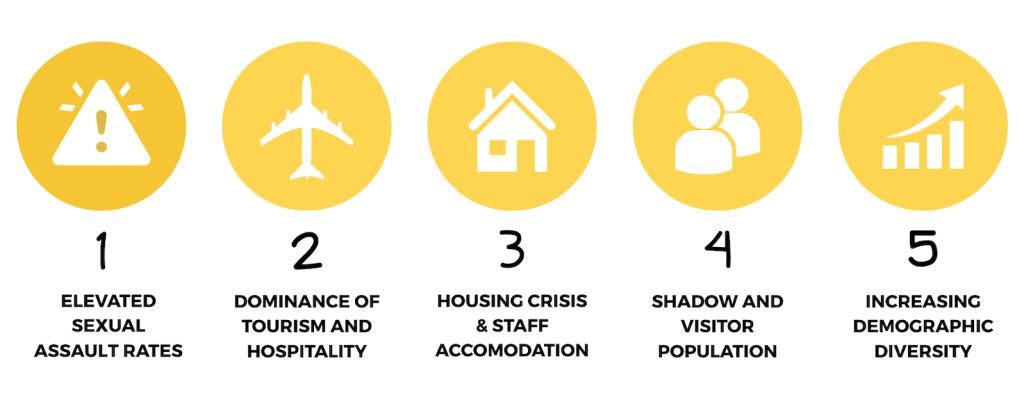
In Banff, over 62% of the workforce is employed in the tourism industry, with a seasonal ‘shadow population’ of 800-1,000 people living in the town along with 4.3 million annual visitors.4 The combination of the seasonal ‘shadow population’, increasing demographic diversity, a pervasive housing crisis, nightlife culture, and the dominance of tourism and hospitality likely contributes to high rates of sexual violence and assault.
Cochrane
Cochrane is one of Canada’s fastest-growing municipalities, known for its western heritage and community hospitality. With rapid population growth in any town, crime and violence tend to rise. This means that Cochrane’s ongoing expansion brings both new opportunities and challenges for preventing and addressing violence.
Key Community Trends

Cochrane’s proximity to Calgary, a large reservation and its strong commuter culture influences the town’s social cohesion and sense of community. Rapid population changes have brought together long-time residents and newcomers, creating a diverse and evolving social landscape in Cochrane.
High River
Known for its scenic location, High River is a rural town with deep roots in agribusiness, ranching, and farming. Much of the workforce in this sector consists of new immigrants and temporary foreign workers, bringing layers of cultural diversity and complexity to how gender norms are understood and reinforced.
Key Community Trends
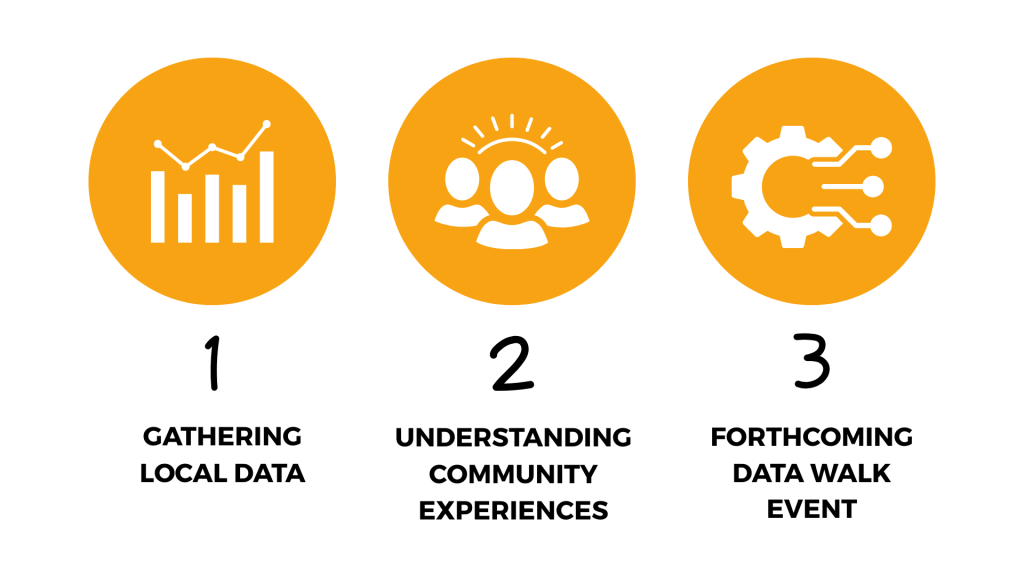
Our work in High River is just beginning, and we are excited to continue engaging with industry and community leaders to gather data and build a profile of the trends that shape violence in this community.
The Research
Project Progress
What have we done?
Next Steps in 2025?
Truly a ‘Made-In-Alberta’ strategy for ending gender-based violence across our province, this project is community-led, research-informed, and grounded in lasting partnerships at the local level.
References
References
1 Rotenberg, C. (2017). Police-reported sexual assaults in Canada, 2009 to 2014: A statistical profile. https://www150.statcan.gc.ca/n1/pub/85-002-x/2017001/article/54866-eng.htm
2 Sinha, M. (2015). Measuring violence against women: Statistical Trends: Highlights. https://www150.statcan.gc.ca/n1/pub/85-002-x/2013001/article/11766/hl-fs-eng.htm
3 Government of Canada. (2019). State of the criminal justice system – 2019 report. Government of Canada. https://www.justice.gc.ca/eng/cj-jp/state-etat/2019rpt-rap2019/p7.html
4 Lee, J. (2023, December 14). Canmore, Banff, Kananaskis key contributors to $25-billion tourism goal. St. Albert Gazette. https://www.stalbertgazette.com/beyond-local/canmore-banff-kananaskis-key-contributors-to-25-billion-tourism-goal-8354067
